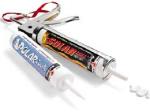Search engine visitors - click here to access entire "$ensible Home" web site
Click here to see a descriptive illustration of often forgotten places to caulk a house.
Related links - House Insulation Tips and Quantity Guide
Dear Jim: It seems to be drafty in my home whenever it is windy outdoors. I have noticed some caulk around the windows is dry and hard. Where should I check for areas to caulk and what is the best caulk to use? - Karen H.

A: If the caulk feels dry and hard, it is probably time to replace it with new caulk. Even though you may not see noticeable cracks and gaps, the caulk is probably not adhering to the window frame or walls. If you dig in it with the tip of a screwdriver, sections of it may fall out.
A house seems to be a strong, rigid structure, but the forces from wind and temperature changes throughout the day and from season to season make it move quite a bit. The purpose of caulk is to be flexible so it remains attached to the housing materials and continues to stop air leakage.
One simple method to find areas that need to be caulked is to hold the back of your hand near windows and doors on windy days. You will be able to feel serious air leaks. Also, move a lighted stick of incense around all the windows and doors and watch the trail of smoke. Even a small air leak will make the thin smoke trail move.
Windows and doors are the most obvious locations for air leakage into a home, but they are not always the worst culprits. The sill area, where the walls rest on the foundation, is often the area of greatest air leakage. In particular, the top of a concrete foundation can be quite uneven leaving many gaps between it and the lumber sill plate.
Check for gaps around the wiring where the main electrical service enters your home. Do the same where the telephone and cable lines come indoors. Holes for plumbing penetrations for outdoor faucets are often much bigger than the diameter of the water pipe.
Check around any penetrations in the ceilings for recessed lights, vent fans, ceiling paddle fans, etc. You will probably have to get up into your attic and move some of the insulation away to check these. While you are up there, also check for gaps where the plumbing vent pipes pass through the attic floor.
When you visit your home center store caulk aisle, you may be overwhelmed by the vast array of different caulking materials. There are many types of specialty caulking materials for specific applications, but you should be able to get by with just several different types.
Also check out the inexpensive caulking tools. Some of these simple tools, for removing the old caulk and for applying a smooth layer of new caulk, can make the job much easier. Since the old caulk is hard and brittle, it probably was not silicone so a caulk remover (softener) chemical should make it easier to remove the caulk. These chemical removers are not as effective on silicone.
Two main categories of caulking materials are "kitchen and bath" and others. Kitchen and bath caulk has special additives to fight mildew. These will be effective any place there is a high moisture level, not just on bathtubs and sinks.
For indoors, where there are not great temperature changes, any latex caulk will be effective. It will have a life of about 20 years or more. It is also paintable. Instead of painting the caulk, kits are available to mix the paint with the latex caulk to tint it for a perfect match. This is an advantage where you want matching caulk between two materials which are not going to be painted such as natural wood, tile, aluminum, etc.
The most common type of caulk used by homeowners is acrylic latex with silicone added. It costs a dollar or two more per tube than plain acrylic latex, but it lasts about 10 years longer and is more durable. The addition of silicone makes the caulk more flexible and it adheres betters to more materials. It is still paintable and cleans up with soap and water.
Silicone caulk is best used where high flexibility is required, often outdoors. Most silicone is not paintable, so it is available in several colors. It is a bit more difficult to lay a smooth bead with silicone caulk, it has an odor as it cures and cleanup is more difficult.
For large gaps, expandable urethane foam caulk is a good choice. It also adds some insulation value to the gap. It is available in low- and high-expansion formulas. The low-expansion type is better for most applications.
Instant Download Update Bulletin No. 937 - buyer's guide and properties of 10 common types of caulk materials, list of 15 manufacturers of caulk and special tools, and tips on how and where to caulk properly, an illustration of suggested places where air leakage occurs in your home, and recommendations on how much caulk is required for several areas.
Dear Jim: I am finally getting around to putting two box fans away for the winter. They are really dirty. What should I do to them so that they are ready to use next summer? - H. H.
A: All you have to do is clean off the dust and lubricate the motor bearings. Just a fine layer of dust on the blades can create air friction that reduces air flow from the fan.
Remove the grill and vacuum the blades. Then wipe them off with soap and water or a spray window cleaner. Use the crevice tool to vacuum dust out of the motor and the bearing oil holes. Put two drops of oil in each oil hole.